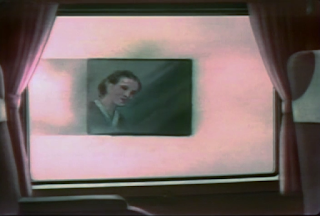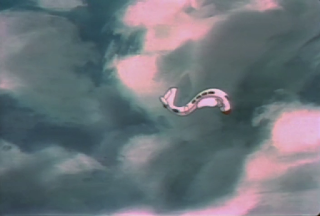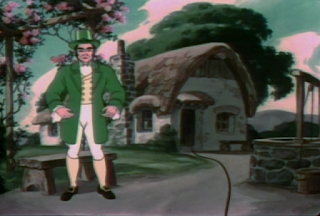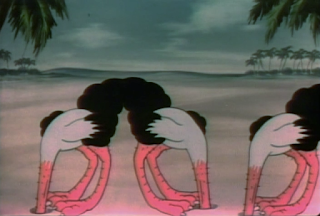DVD/BR AVAILABILITY: none
You may view a not-so-hot but uncut print of this cartoon HERE. The screen grabs are provided by our great pal Devon Baxter, and make this frequency of posting possible. Please check out and support Devon's Patreon page. He's doing superb work in determining who did what in these classic cartoons, where the film credits usually bely the artists who worked on them.
Here we go with the last year of this blog. I intend to complete this project in 2020. I've dawdled too much, and have often set this blog aside when paying projects demanded my attention. I'm so close to the finish line (and semi-retired) now that I resolve to get through this final spate of Avery-at-WB cartoons as often and as well as I can.
There are still some surprises remaining in Avery's Schlesinger cartoons. Few are seen in Aviation Vacation, a film notable for the birth of one of its maker's most inspired moments. This gag, refined to perfection in the 1952 release Magical Maestro, is the main joy of this by-the-book spot-gagger.
This was the last spot-gag cartoon completed by Avery before he left the Leon Schlesinger studio. Surviving prints look as bad as many of Avery's M-G-M cartoons. It's never been restored for reasons soon apparent. When shown on television, about a minute of footage went missing. Again, all will be revealed...
In a clever start, the camera trucks stage left to reveal the brick wall of an airport. This opens onto an airfield.
Avery's love of split-screen gags is among his defining traits. Here, a clever payoff (complete with dotted line) shows Wendell Willkie, who lost the 1940 election to Franklin D. Roosevelt. Willkie's name is referenced in later Schlesinger cartoons. A funny name is always a gift.
For 42 seconds--an eternity in Avery's world--this Erin songfest goes unabated.
It's not unusual for Avery to wrap a travelog spoof with a moment of drama. As if anyone in the audience bought the drama for one second...
Taxiing towards New York, "we encounter a heavy fog which makes visibility poor and landing difficult..."
<><><><><><><><>
Here we go with the last year of this blog. I intend to complete this project in 2020. I've dawdled too much, and have often set this blog aside when paying projects demanded my attention. I'm so close to the finish line (and semi-retired) now that I resolve to get through this final spate of Avery-at-WB cartoons as often and as well as I can.
There are still some surprises remaining in Avery's Schlesinger cartoons. Few are seen in Aviation Vacation, a film notable for the birth of one of its maker's most inspired moments. This gag, refined to perfection in the 1952 release Magical Maestro, is the main joy of this by-the-book spot-gagger.
This was the last spot-gag cartoon completed by Avery before he left the Leon Schlesinger studio. Surviving prints look as bad as many of Avery's M-G-M cartoons. It's never been restored for reasons soon apparent. When shown on television, about a minute of footage went missing. Again, all will be revealed...
In a clever start, the camera trucks stage left to reveal the brick wall of an airport. This opens onto an airfield.
Our narrator doubles as airport announcer and imparts the cartoon's feather-light premise: a world tour via air. It's an engaging approach. Avery perhaps sensed that the traditional narrator bit had worn thin, and sought a novel way to start the proceedings. As always, the viewer waits for the first violation of apparent sobriety.
"Track fast," the announcer intones, and about 750 people flood the airplane. (This, by the way, was how a person boarded an airplane until the 1980s... just walked out on the tarmac up a stair-ramp right into the darned thing. I recall doing this several times in my youth.)
One appreciates the acceleration of Avery's timing in these last Schlesinger shorts. Two years earlier, this moment might have taken five to 10 seconds. Here, it's done in three seconds; the sudden burst of movement and sound, followed by an empty frame, has a delightful impact.
Plane takes off as would a bird, in a clever concept that doesn't overstay its welcome.
NARRATOR: Ah, sunny California...where the sun is always shining!
PAYOFF: Exactly what you'd expect.
Carl Stalling pits "April Showers" against impressive effects animation
of the plane struggling through a rainstorm.
Next, a gag cribbed from the recent Ceiling Hero, with some animation re-use.
(Ceiling Hero version.)
Some clever additions; the plane shadow folding its wings to "fit" into the tunnel is a nice touch.
Kind of handsome the way those train tracks line up in these screen grabs, but the Ceiling Hero version is funnier. Now howzabout a Mount Rushmore gag? One that eats up a lot of screen time with no animation, gives the background artist some show-off moments, and ends with a political gag that needs explanation?Avery's love of split-screen gags is among his defining traits. Here, a clever payoff (complete with dotted line) shows Wendell Willkie, who lost the 1940 election to Franklin D. Roosevelt. Willkie's name is referenced in later Schlesinger cartoons. A funny name is always a gift.
(the real Wendell Willkie)
"Night finally overtakes us... ah, what a beautiful night..."
The half-moon gag was one of the few scatalogical jokes that made it past the Hays Office.
I think Avery did these gags just because he could.
Another gag Avery (and other cartoon-makers) favored:
"Next morning, far out at sea, we pass our sister ship, returning from the Orient..."
No ethnic caricatures--just a wonderful confusion of travel modes. Most people traveled by train in 1941, and the affect of a passing train (complete with SFX) is clever and playful.
This gave the background artist a rare chance to paint human beings in realistic style. I'm sure he was pleased with the show-off opportunities in Aviation Vacation.
Is that Adolf Hitler?
A rendition of "Over the Waves," the history of which we've discussed before, frames a cute interlude of finny aeronavigation.
"Our first stop is the Emerald Isle..."
"Let's listen to this quaint old Irish ballad--dear to the hearts of every true Irishman..."
This looks rotoscoped, but it's the masterful animation of Robert McKimson. This is an ambitious attempt to animate the realistic human figure. Despite some awkward poses (endemic in the animation procedure), McKimson does a superb job, and, in best Avery tradition, fortifies a deceptively serious moment with proper weight and gravity.
"Sing it, Patrick!"
Note wiggling hair at lower right.
And left, and all over the frame. This is the rough draft of one of Avery's most brilliant meta-gags. Modern movie audiences don't experience the inconveniences we geezers suffered. Out-of-focus, mis-framed, scratchy, dirty, oily film, which burned, broke, jittered and attracted detritus like a magnet. Common among these gatherings were the projectionist's hairs, which clung to the film gate and aperture frame and caused many a complaint to the bored staff in the theater lobby.
This performance of "When Irish Eyes are Smiling," with its graceful, smooth animation and Stalling's sober, lush orchestration, might have moved some 1941 filmgoers.For 42 seconds--an eternity in Avery's world--this Erin songfest goes unabated.
Until...
"HEY!"
"YOU UP THERE!"
"GET THAT HAIR OUTTA HERE!"
Silhouette of projectionist's hand enters frame...
...plucks distracting follicle,
Deadly silence during this procedure adds to its impact.
Song completes, and for all intents and purposes, so does this cartoon. What follows has banished this film from TV showings since at least the 1980s (I recall catching it on TV a couple of times in the '70s.)
Before we move on, we must pay homage to the fruit of this celluloid labor--the brilliant reworking of this concept in the 1952 release Magical Maestro, which we hope WHV will get around to restoring and releasing on Blu-Ray:
The above frame is perhaps the best moment of Avery's career. Again, dead silence freezes our attention in this destruction of the distance between cinema and cinema-goer.
Back to 1941, and material that is not "woke" in any way, shape or form.
Narrator informs us that we're approaching "darkest Africa." Plane vibrates to a watusi rhythm. You know what you're in for.
"The primitive beat of the tom-toms, to send messages from one tribe
to another, is still used by the natives."
The animation in this establishing shot looks rotoscoped.
A moody, elaborate pan establishes the distance the message travels.
Message is intercepted and further relayed.
And here... well, you know... an ignoble payoff to an elegant set-up, to say the least.
Let's not dwell on this. The sequence runs from 5:05 to 5:21, and, despite grade-A animation, is beyond the pale. I am more than tolerant of such passages, as a historian of popular culture of the 20th century, so when I'm squeamish about presenting something, that should speak to its problematic issues.
So...
Our narrator discusses the native tribesmen and their "deadly accuracy" with poison-tipped blow-gun darts. This at least provides a classic Avery reversal-of-expectations gag.
"Teh'ble shot, Joe. Teh'ble shot."
"Ostriches, when frightened, bury their heads in the sand to hide themselves."
Dumb-but-benign joke. Doofus-voiced, buck-toothed ostrich enters, asks:
"Hey.... where is ev'rybody?"
"Interesting to behold is the evolution of a
tropical butterfly..."
Narrator goes on at length of the remarkable transformation as these merrily-colored insects emerge from their cocoons.
Camera pans stage left. You know this is going to be a "rule of three" joke.
Yep.
This pitiful thing whose limbs tremble with weakness and whose wings appear moth-eaten helps to transcend the joke you KNOW is coming. Narrator is shocked at butterfly's sad shape and inquires. Butterfly answers...
"Well... I've been sick."
This dreary print can't douse the intense cyclamen hues of this Technicolor sunset.
Narrator makes with the heavy-heart bit as we bid farewell to this curiously stacked global air-visit. Plane does a charming lilt to Stalling's almost-swingy "Aloha Oe."Taxiing towards New York, "we encounter a heavy fog which makes visibility poor and landing difficult..."
Plane receives orders to "circle the field before coming in..."
...and Aviation Vacation ends with a Famous Studios-esque "hunh?!?" gag.
The concept of the spot-gag travelog was one of Avery's big innovations of the late 1930s. It gave him a forum to burst the balloons of filmic pretension, spoof a cliche of the Depression-era movie programme and, within this parody, rattle the frames of film and their implicit relationship to the filmgoer.
This format led to a couple of outstanding cartoons (Detouring America, Cross Country Detours and parts of Land of the Midnight Fun) but the staleness of this film shows the formula worn to extinction. Not that Avery's invention, humor or love of razzing film form had petered out; the hair-in-projector gag is a landmark moment. In a few spots, a playfulness of tone lends a breezy air to proceedings that are in desperate need of help.
The Africa sequence aside (which, with two brief gags, was scissored out of TV prints once someone noticed they were there), there's nothing wrong or horrible about the film. Its craftsmanship and artistry is solid--from atmospheric special effects animation to McKimson's innovative movement of the lifelike human form. Content-wise, it has no real reason to exist. At its worst, its humor descends to the level of Avery's imitators.
Most of all, Aviation Vacation shows Avery's weariness with the Schlesinger operation. He had done all he could do within the limited but ambitious means of the studio. Had he remained with Schlesinger, he could have only spun his wheels and done prolix follow-ups to films that stood on their own as classics.
Avery needed more elbow room--larger budgets, bigger facilities--to fully realize his comedic vision. At Metro-Goldwyn-Mayer, where he was already at work on his first releases for his new studio as this cartoon hit theaters, Avery found what he needed. It's notable that he did just one spot-gag film (the inferior Batty Baseball) in the early years of his M-G-M stay. He would briefly breathe new life into the formula with his close-of-decade series of "Tomorrow" shorts, and with the experiment in cartoon-modern graphics, Symphony in Slang.
Up next is my least favorite Avery cartoon. I'll have to work up the courage to approach it. As an abberant experiment in mis-use of a star character and for its ghastly racial caricature, it's an unfortunate nadir for all hands involved. Something to look forward to!
It had to happen sometime: All This and Rabbit Stew is next.







































































































































































































End gag with the fog recalls the cruise ship balancing on top of the Trylon at the end of "Land of the Midnight Fun", but the absurdity of that payoff was better. Which kind of sums up the whole cartoon -- spot gags whose variations had for the most part been done better in previous Avery cartoons.
ReplyDeleteAll This and Rabbit Stew is the first of Tex's WB work to not credit him. Was this because of his suspension or for some other reason?
ReplyDeleteI would assume so. It appears to have been a public acknowledgment that Avery was no longer in Schlesinger's employ, as seen by the absence of director credit on films by Bob Clampett and Frank Tashlin released after they had left the studio. Perhaps it was Leon Schlesinger's version of "you're dead to me."
DeleteIt was all because of the final gag in 1941's THE HECKLING HARE, where Bugs and the dumb dog chasing him, after ONE big fall, go thr ANOTHER one, both off a huge cliff, and Bugs says, "Well, HERE WE GO AGAIN", as in a then-current risque bit..Steve
DeleteThe 'hair' gag would also be done famously by Benny Hill in 1984 during one of his ending chase scenes. Benny clearly seemed to be one of those who loved Tex Avery cartoons. I always thought early Hill's Angels routines, in their structure and formula, borrowed heavily from Avery's 1943-49 string of "Wolf / Red" cartoons (from "Red Hot Riding Hood" to "Little Rural Riding Hood").
ReplyDelete